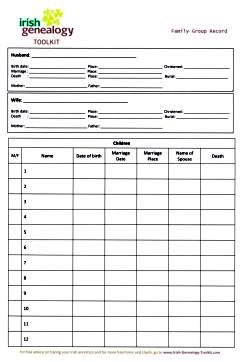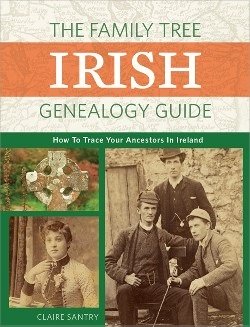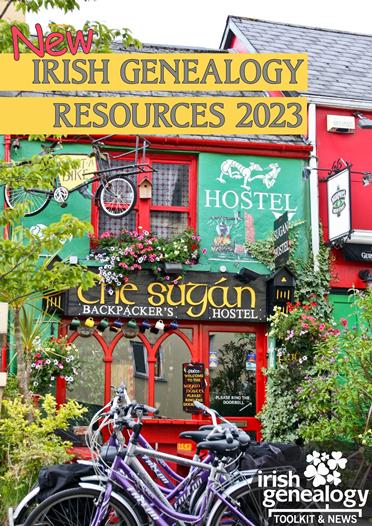- Home ›
- Free Family Tree forms & charts ›
- Family Group forms
Family tree forms for recording family groups
Ideal for the big
families so often found in Irish genealogy
Family tree forms such as the Family Group Record concentrate on one family group. The form that's available to download below can hold information about a husband, a wife and their children. I've deliberately included space for twelve children because big families are so much a feature of Irish genealogy, but it doesn't matter if your own ancestors had fewer kids.
The eldest child is traditionally listed first, with younger children following in order of birth.
Properly documented, family tree forms like this can save the day for a frustrated genealogist because it will be crammed with clues and alternative ideas on where to look for genealogy information about your family.
For example, let's say you don't know the name of the mother of Tom, one of your direct male ancestors. You have Tom's marriage certificate so you know his father was Daniel but, despite hunting high and low, you can't locate Tom's birth record which would show his mother's name.
Over time you might be able to fill in Daniel's Family Group Record form with details of his children. From those details you may be able to find a birth certificate or baptism record for one of Tom's brothers or sisters, and this should tell you Tom's mother's name.
To download the form (pdf), click/tap the image above.
Size of Irish families
Irish families were remarkably larger than in other European countries. This was noted throughout the 19th century by politicians and other commentators. While I don't dispute these observations, I've not been able to find any statistical evidence to show here. However, the 1911 census found that women who had married between 1877 and 1881 averaged 6.8 children each.
It is a very high average number, and explains why the size of my grandfather's family (11 children) and my grandmother's family (10 children) were not so exceptional in the first decade of the 20th century.
Indeed, by 1946, families of 10 children or more still made up 13% of all families in the Republic. The largest single group were the 33% of families with 6-9 children, followed by 30% of families with 3-5 children. Families with only one or two children made up under 13%, while those without any children made up the remaining 10% of family groups.
Between 1946 and 1982 the number of families with 6 or more children fell dramatically, from 28,000 to 16,000.
Since most Irish genealogy researchers are studying 19th century ancestors, I've made sure the family tree forms downloadable on this page cater for families with up to 12 children!
Size of Irish families
Irish families were remarkably larger than in other European countries. This was noted throughout the 19th century by politicians and other commentators. While I don't dispute these observations, I've not been able to find any statistical evidence to show here. However, the 1911 census found that women who had married between 1877 and 1881 averaged 6.8 children each. It is a very high average number, and explains why the size of my grandfather's family (11 children) and my grandmother's family (10 children) were not so exceptional in the first decade of the 20th century.
Indeed, by 1946, families of 10 children or more still made up 13% of all families in the Republic. The largest single group were the 33% of families with 6-9 children, followed by 30% of families with 3-5 children. Families with only one or two children made up under 13%, while those without any children made up the remaining 10% of family groups.
Between 1946 and 1982 the number of families with 6 or more children fell dramatically, from 28,000 to 16,000.
Since most Irish genealogy researchers are studying 19th century ancestors, I've made sure the family tree forms downloadable on this page cater for families with up to 12 children!
The Family Tree Irish Genealogy Guide
Written by the creator of Irish Genealogy Toolkit and Irish Genealogy News, 'The Family Tree Irish Genealogy Guide' is full of advice, tips and strategies to ease what can be a challenging journey.
Its guidance will be useful to any researcher of Irish heritage, but especially for the target Irish-American researcher who's struggling to work back to Ireland from their immigrant ancestor.
Publisher: Penguin
ISBN: 9781440348808 / 240 pages.


